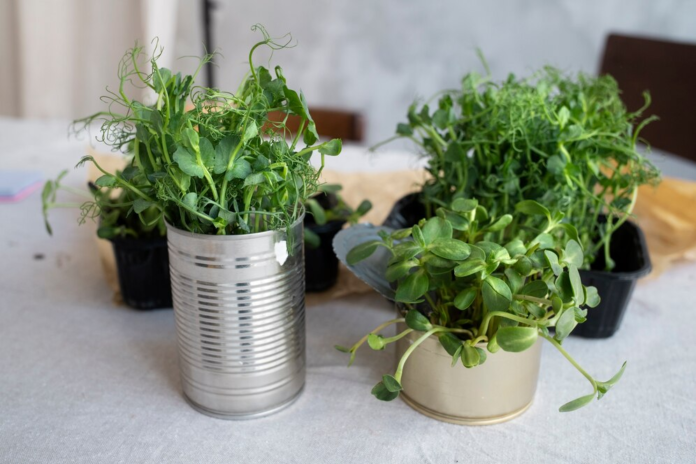Cilantro, with its vibrant leaves and aromatic flavor, is a versatile herb that adds zest to a myriad of culinary delights. Growing cilantro indoors allows you to enjoy its freshness year-round, right in the comfort of your home. In this comprehensive guide, we explore the steps and considerations to successfully cultivate cilantro indoors, ensuring a constant supply for your kitchen endeavors.

Selecting the Right Cilantro Variety
Before delving into the world of indoor cilantro cultivation, it’s essential to choose the right variety. Slow-bolting varieties, such as Santo or Calypso, are particularly well-suited for indoor growing. These varieties are less prone to quickly producing flowers, allowing for an extended harvest period.
Gathering Your Indoor Gardening Essentials
1. Containers:
Select containers with good drainage to prevent waterlogged soil, which cilantro dislikes. A width of at least 8-10 inches and a depth of 8-12 inches per plant is ideal. Consider using multiple smaller pots to stagger planting and harvesting.
2. Soil:
Cilantro thrives in well-draining soil. Use a high-quality potting mix enriched with organic matter. You can enhance drainage by adding perlite or sand to the mix.
3. Light:
Cilantro loves sunlight, so choose a sunny spot for your indoor garden. Place your containers near south or west-facing windows to ensure your cilantro receives at least 4-6 hours of direct sunlight daily. If natural light is insufficient, supplement it with fluorescent or LED grow lights.
4. Watering Can:
Cilantro prefers consistent moisture. Use a watering can with a fine spray to keep the soil evenly moist. Water when the top inch of soil feels dry to the touch.
5. Seeds or Seedlings:
You can start cilantro from seeds or purchase seedlings from a nursery. If using seeds, soak them in water for 24 hours before planting to encourage faster germination.
Planting Cilantro Seeds or Seedlings
1. Planting Seeds:
- Fill your chosen containers with the prepared potting mix.
- Sow cilantro seeds directly on the soil surface, pressing them lightly into the soil.
- Cover the seeds with a thin layer of potting mix.
- Water gently to settle the soil.
2. Transplanting Seedlings:
- If using seedlings, transplant them into your containers, leaving a spacing of 4-6 inches between plants.
- Ensure the root ball is well-covered with soil.
- Water thoroughly after transplanting.
Providing Care for Your Indoor Cilantro Garden
1. Sunlight:
Cilantro requires plenty of sunlight to thrive. Ensure your indoor garden receives at least 4-6 hours of direct sunlight daily. Rotate the containers regularly to expose all sides of the plants to sunlight.
2. Watering:
Keep the soil consistently moist. Water when the top inch of soil feels dry, but avoid overwatering to prevent root rot. Use a saucer under the containers to catch excess water and prevent waterlogging.
3. Thinning Seedlings:
If you started cilantro from seeds, thin the seedlings once they reach a few inches in height. Leave 4-6 inches of space between each plant to allow for proper growth and air circulation.
4. Fertilizing:
Cilantro is not heavy feeders, but a balanced, water-soluble fertilizer can be applied every 4-6 weeks during the growing season. Follow the package instructions for proper dilution.
5. Pruning and Harvesting:
Regular pruning encourages bushier growth and delays bolting. Harvest leaves when they are young and tender. Use clean scissors or pruning shears to snip off the outer leaves, leaving the central growth point intact.
6. Preventing Bolting:
Bolting, the process of cilantro producing flowers and going to seed, can be delayed by:
- Harvesting regularly to prevent the plant from reaching maturity.
- Providing adequate spacing between plants for proper airflow.
- Keeping the plants cool and well-watered.
7. Dealing with Pests:
Keep an eye out for common pests like aphids or spider mites. If pests appear, wash the leaves with a gentle spray of water or use insecticidal soap.
8. Companion Planting:
Cilantro benefits from companion planting with herbs like basil and chives. This not only enhances the flavors of your herbs but can also help repel certain pests.
Extending the Harvest
1. Successive Planting:
To ensure a continuous supply of cilantro, consider successive planting. Start new seeds every 2-3 weeks, allowing you to harvest fresh leaves while the next batch is growing.
2. Overwintering Indoors:
Cilantro is sensitive to extreme temperatures. In colder climates, bring your cilantro pots indoors during the winter to protect them from frost. Ensure they still receive adequate sunlight.
Troubleshooting Common Issues
1. Bolting:
If cilantro starts to bolt despite your efforts, consider allowing a few plants to flower and go to seed. This provides seeds for future plantings.
2. Yellowing Leaves:
Yellowing leaves may indicate overwatering or poor drainage. Adjust your watering practices and check the soil for proper drainage.
3. Leggy Growth:
Leggy growth may result from insufficient light. Ensure your cilantro receives enough sunlight or supplement with artificial lighting.
Conclusion
Growing cilantro indoors is a rewarding venture that allows you to enjoy the freshness of this flavorful herb year-round. With the right care, attention to sunlight, and a bit of patience, you can cultivate a thriving indoor cilantro garden that elevates your culinary experiences. Embrace the joy of nurturing this versatile herb in the heart of your home, and relish the satisfaction of harvesting homegrown cilantro for your favorite dishes.
Also read: Safe Plants for Cats: A Guide to Feline-Friendly Greenery



